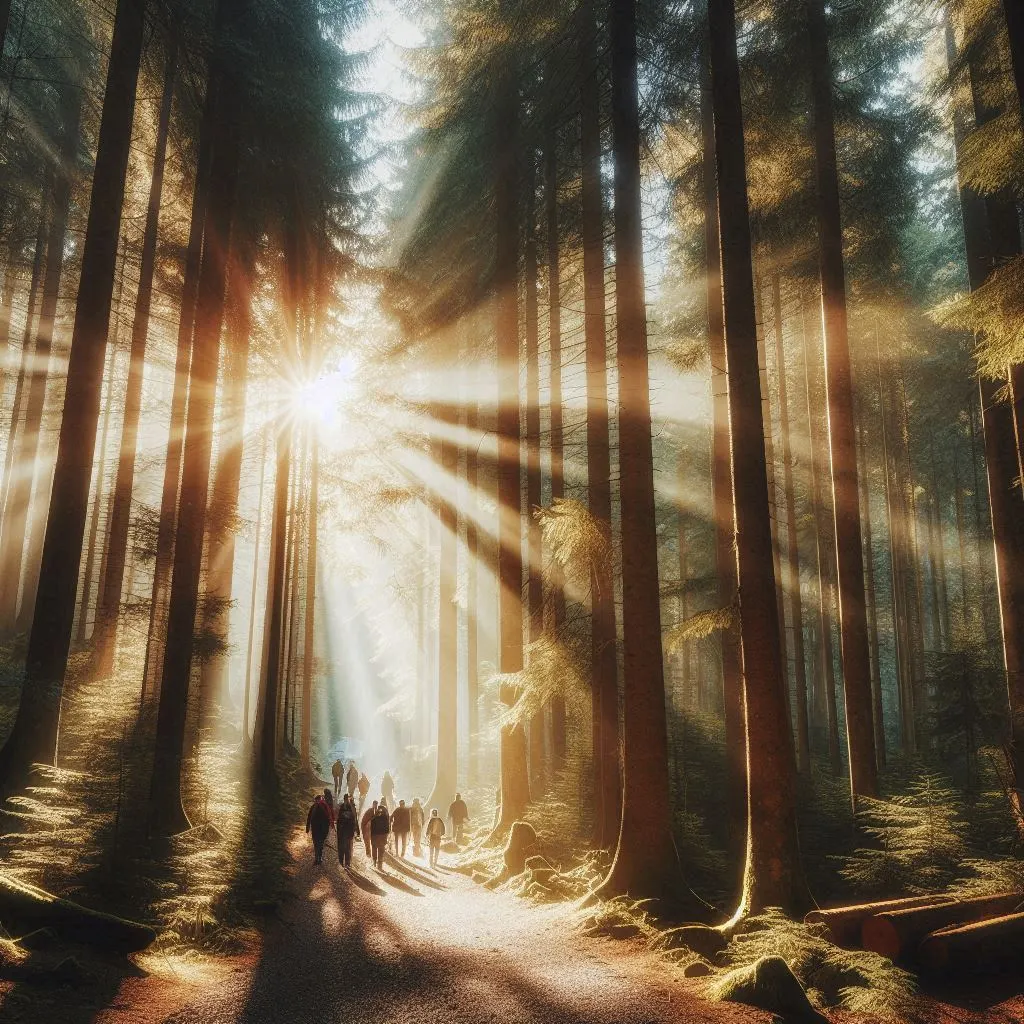- 100 Attractions in the World 2025 In-Depth Guide - 05/13/2025
- 100 Best Life Hacks 2025 In-Depth Guide - 05/12/2025
- 100 Easy Dinner Ideas 2025 In-Depth Guide - 05/09/2025

Table of Contents
Trails: 2025 Pathways to Discovery and Connection
Trails, both ancient and modern, are pathways that symbolize exploration, culture, and connectivity. Whether winding through dense forests, skirting rugged coastlines, or threading through bustling urban centers, trails hold immense significance for recreation, conservation, and community development. This article explores the world of trails, focusing on their historical roots, ecological roles, and future prospects.
Definition and Types of Trails
Trails are marked paths or routes designed for a variety of activities, such as hiking, biking, cultural exploration, and wildlife observation. They vary greatly in purpose and structure, from ancient pilgrimage routes to modern urban greenways.
Types of Trails
| Type | Purpose | Examples |
|---|---|---|
| Hiking Trails | Recreation and physical activity in natural areas. | Appalachian Trail (USA), Overland Track (Australia) |
| Cultural Trails | Routes with historical or spiritual significance. | Camino de Santiago (Spain), Kumano Kodo (Japan) |
| Urban Trails | Walking or cycling paths within cities. | The High Line (USA), Thames Path (UK) |
| Wildlife Trails | Observing and protecting ecosystems. | Amazon Rainforest Trails (Brazil), Serengeti Safari Trails (Tanzania) |
| Long-Distance Trails | Extended routes covering diverse terrains. | Pacific Crest Trail (USA), Great Himalayan Trail (Nepal) |
Global Highlights: Iconic Trails
From ancient pilgrimages to modern hiking adventures, trails across the globe offer diverse experiences.
| Trail Name | Region | Length (km) | Unique Features |
|---|---|---|---|
| Appalachian Trail | USA | 3,540 | Spanning 14 states; diverse ecosystems. |
| Camino de Santiago | Spain and Europe | Varies | Historic pilgrimage with rich cultural sites. |
| Great Wall Path | China | ~21,196 | UNESCO site; unparalleled historic views. |
| Inca Trail | Peru | 42 | Leads to Machu Picchu; historical significance. |
| Te Araroa Trail | New Zealand | 3,000 | Coastal landscapes and mountain vistas. |
Historical Importance of Trails
Trails have long served as conduits for trade, migration, and cultural exchange.
- Silk Road: A network of ancient trade routes linking Asia, Europe, and Africa.
- Roman Roads: Built to connect the vast Roman Empire, many serve as trails today.
- Pilgrimage Routes: Paths like the Camino de Santiago shaped spiritual journeys.
Trails often intersect with the stories of civilizations, acting as markers of human progress.
Trails and Ecological Preservation
Biodiversity Hotspots
Trails can protect biodiversity by concentrating human impact along defined paths, reducing widespread disturbance. For example:
- Amazon Rainforest Trails: Regulated tours promote conservation and eco-tourism.
- Yellowstone National Park (USA): Trail systems safeguard sensitive geothermal features and wildlife habitats.
| Region | Trail Name | Key Conservation Efforts |
|---|---|---|
| Amazon Rainforest | Eco-Trails | Promotes awareness and sustainable tourism. |
| Himalayas | Great Himalayan Trail | Helps prevent deforestation and erosion. |
| African Savannah | Wildlife Safari Trails | Protects habitats of endangered species. |
Economic and Community Benefits
Trails are significant economic drivers, generating income through tourism, events, and related businesses.
Economic Contributions
- Appalachian Trail: Contributes approximately $24 million annually to local economies.
- Camino de Santiago: Generates over €280 million each year from pilgrim-related activities.
- West Highland Way (Scotland): Supports local inns, shops, and transport services.
| Trail | Annual Visitors | Economic Contribution |
|---|---|---|
| Appalachian Trail | ~3 million | $24 million |
| Camino de Santiago | ~300,000 pilgrims | €280 million |
| West Highland Way | ~120,000 | £20 million |
Trails also strengthen communities by fostering outdoor recreation, which improves public health and reduces urban stress.
Health Benefits of Trails
Trail activities are proven to enhance physical and mental health. A study published in Nature reveals that spending 120 minutes a week in natural environments significantly reduces stress and improves overall well-being.
Key Benefits
- Cardiovascular Health: Regular hiking lowers heart disease risk.
- Mental Clarity: Nature immersion enhances cognitive function.
- Social Connections: Group hikes foster social bonds and reduce loneliness.
Challenges and Solutions in Trail Management
While trails are vital assets, they face several challenges:
- Overuse: Popular trails experience erosion, littering, and crowding.
- Solution: Implement visitor limits and reservation systems.
- Climate Change: Rising temperatures and extreme weather disrupt trail ecosystems.
- Solution: Adaptive trail design and restoration projects.
- Funding Gaps: Maintenance often relies on limited public and private funding.
- Solution: Introduce sustainable tourism fees and sponsorships.
| Challenge | Example Trail | Proposed Solution |
|---|---|---|
| Overcrowding | Mount Everest Base Camp | Strict permits and regulated access. |
| Environmental Degradation | Kilimanjaro Trails | Enforce eco-tourism guidelines. |
| Insufficient Funding | Pacific Crest Trail | Leverage partnerships with local businesses. |
Technological Innovations in Trails
Technology is transforming how we navigate and preserve trails:
- GPS and Mapping Apps: Platforms like AllTrails provide real-time navigation and route planning.
- Smart Trail Systems: Sensors monitor usage and environmental conditions.
- Virtual Trails: 3D walkthroughs for remote exploration and planning.
Case Study:
The Great Ocean Walk in Australia integrates eco-friendly apps for navigation and educational content, enhancing visitor experience while promoting conservation.
Trails of the Future: Sustainability and Inclusivity
Future trail development must focus on sustainability and accessibility.
Sustainable Trail Practices
- Use of recycled materials for trail construction.
- Restoration projects to mitigate erosion and habitat damage.
Inclusive Trail Design
- Accessible Trails: Paths like the Braille Trail in Colorado accommodate visually impaired visitors.
- Community Engagement: Involving local stakeholders ensures that trails meet diverse needs.
Trails to Add to Your Bucket List
- Tour du Mont Blanc (Europe): A 170-km circuit around the Alps.
- The Narrows (USA): A slot canyon hike in Zion National Park.
- Sentiero Azzurro (Italy): Scenic coastal views of Cinque Terre.


Conclusion
Trails are more than paths; they are lifelines connecting people, cultures, and nature. By embracing sustainable practices and fostering community stewardship, we can ensure that trails continue to inspire and enrich lives for generations to come.
References
- Outdoor Industry Association. (2023). The Outdoor Recreation Economy. Read More
- World Trails Network. (2023). Global Trail Statistics. Link
- UNESCO. (2022). Cultural Routes and Their Global Significance. Link
- White, M.P., et al. (2019). Spending Time in Nature Improves Well-being. Journal of Nature
Recommended Articles:
Toy Poodle: The Perfect Petite Companion – love a happy home (loveahh.com)
- How to Choose the Right Perfume for Yourself
- Amazon Best Sellers in Skin Care Products Top 10 2025
- Perfume: Everything You Need to Know 2025
- Burberry Her Perfume: A Deep Dive 2025
- Ariana Grande Perfume: A Complete Guide 2025
- YSL Perfume: A Legacy of Luxury and Elegance 2025
- Sol de Janeiro Perfume: A Luxurious Fragrance 2025
- Billie Eilish Perfume: A Complete Guide 2025
- Delina Perfume: A Comprehensive Guide 2025
- Kayali Perfume: A Comprehensive Guide 2025
- Miss Dior Perfume: A Comprehensive Guide 2025
- Valentino Perfume: A Comprehensive Guide 2025
- How to Increase Charisma: Women’s Edition 2025
- How to Increase Charisma: Men’s Edition 2025
- Amber: That Captivates the World 2025
- What Color Is Amber 2025?
- Makeup Looks: 2025 Finding Your Unique Style
- Polygel Nails: 2025 Nail Revolution
- Mouse Pretty Makeup: 2025 Whimsical Beauty Trend
- Builder Gel Nails: 2025 Perfect, Long-Lasting Nails
- Trendy Short Gel Nails: 2025 Style Meets Practicality
- Makeup Bag: 2025 Your Beauty Companion
- Wedding Makeup Looks: 2024 Ultimate Guide
- Christmas Makeup Looks: 2024 Glamorous Ideas
- 80s Makeup Looks: Bold, Bright, and Unforgettable
- Cute Makeup Looks: 2025 A Comprehensive Guide
- Natural Makeup Looks: 2025 Enhance Your Natural Beauty
- How to Remove Gel Nails Safely at Home
- Ombre Nails: 2024 Gorgeous Manicure Trend
- Autumn Nails Trends: Best Fall Nails
- Cute Fall Nails: Trendy Nail Ideas
- Fall Nails 2024: Trendy Colors, Designs, and Styles
- Festive Christmas Nails Ideas: Inspire Holiday Look
- Christmas Nails 2023: Festive Trends
- Summer Nails 2024: Top Trends
- 10 Cute Acrylic Nails Ideas to Elevate Your Look
- Beauty of Square Short Acrylic Nails: A Practical Guide
- Square Short Acrylic Nails: Stylish and Practical
- Cute Short Acrylic Nails Ideas: Trendy Look
- Cute Short Acrylic Nails: Perfect Look
- Best Short Acrylic Nails Ideas(15 Types)
- Trendy Short Acrylic Nails Ideas(13 Types)
- Short Acrylic Nails: Perfect Style with Practicality
- Short Acrylic Nails: Stylish, Durable, and Practical
- Acrylic Nails Ideas: 10 Trendy Designs
- How to Remove Acrylic Nails(1 In-Depth Guide)
- The Ultimate Guide to French Tip Nails(6 Types)
- French Tip Nails: A Timeless Style with a Modern Twist
- How to Achieve the Perfect Glazed Donut Nails


















































